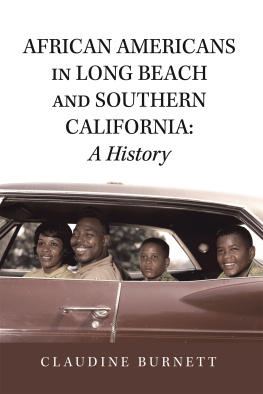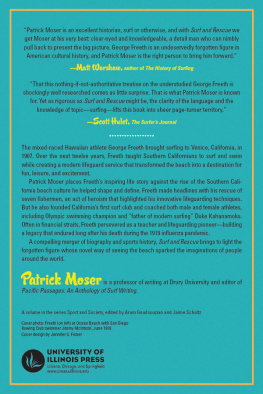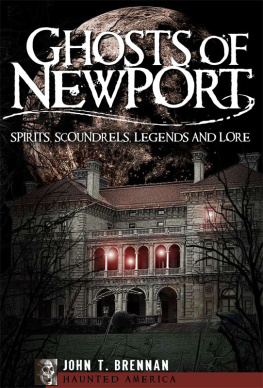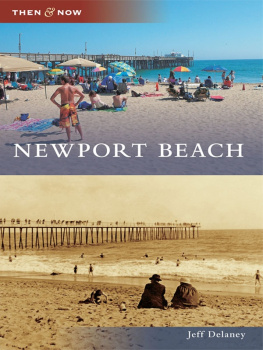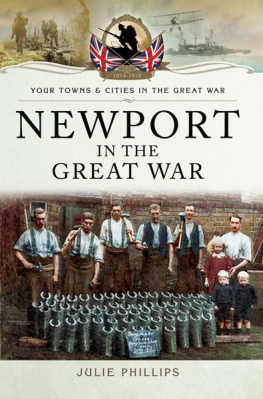
Published by The History Press
Charleston, SC 29403
www.historypress.net
Copyright 2013 by Claudine Burnett and Paul Burnett
All rights reserved
Photos courtesy of the Surfing Heritage & Culture Center, First American Title Insurance Companys Historical Collection, Orange County Archives, Sherman Library, the authors and Woody Woodworth.
First published 2013
e-book edition 2013
Manufactured in the United States
ISBN 978.1.61423.956.7
Library of Congress CIP data applied for.
print edition ISBN 978.1.60949.840.5
Notice: The information in this book is true and complete to the best of our knowledge. It is offered without guarantee on the part of the authors or The History Press. The authors and The History Press disclaim all liability in connection with the use of this book.
All rights reserved. No part of this book may be reproduced or transmitted in any form whatsoever without prior written permission from the publisher except in the case of brief quotations embodied in critical articles and reviews.
Dedicated to the surfers who first rode
Corona del Mar/Newport Beach
and whose souls continue to ride the
spirit waves of Corona del Mar.
Contents
Acknowledgements
Our thanks to all those who have helped us in our quest to keep Newport Beach history alive: the Sherman Library and Gardens, the Newport Beach Public Library, the Orange County Historical Society, the Surfing Heritage & Culture Center, the Newport Beach Historical Society, the Newport Harbor Nautical Museum, the Balboa Island Museum and Historical Society, First American Trust, Jill Thrasher, Spencer Croul, Steve Farwell, Sharon Marshall, Woody Woodworth, Nancy Gardner, Steve Cleary and Steve Wilkings.
Wed also like to thank the Vultee, Waters, Thomas, Zahn, Ball, Peterson, Gregg and Huffman families, whose photos, donated to the Surfing Heritage & Culture Center, are used in this book.
Introduction
Today, Newport Beach is considered the uncrowned jewel of Orange Countys Gold Coast, the glitz-and-glamour center of the West Coast. Its a city composed of various communities, including Corona del Mar, Balboa Island, Balboa Peninsula, Newport Coast, San Joaquin Hills, Santa Ana Heights and West Newport. Here there are multimillion-dollar residences, million-dollar yachts and usually two Mercedes and a Jaguar in garages the size of most peoples homes. But the Newport Beach youre going to find in this book is quite different. Its the Newport Beach before World War IIa lively, lusty, beach resort where rum runners openly docked and unloaded their illegal brew and where drinking, gambling and dancing paid the bills. It was a city that was hell on wheels from Memorial Day to Labor Day before going into hibernation the rest of the year except for a brief awakening during Easter vacation. It was a city where every weekend during the summer there was some aquatic event that included wave ridingbut not the kind you think of today. Aquaboarding was the common mans way of tackling the ocean, standing on an aquaplane board, holding on to an attached rope and being pulled by a boatan early ancestor of water skiing.
Back then, surfboards were big and heavy. The most famous surfer of the age, Duke Kahanamoku, rode the waves of Newport Bay in a canoe, and when he could, he borrowed an actual surfboard from his friend Felix Modjeski, grandson of famous Polish actress Madame Helena Modjeska, who owned a nearby beach cottage. Eventually, Duke and some of his friends brought their own surfboards to Corona del Mar and left them at the Sparr Bathhouse (the boards were too heavy to carry back and forth), starting what would become one of the first surf clubs in the United Statesthe Corona del Mar Surf Club. It was this club that initiated the first surf contest on the mainlandthe Pacific Coast Surfboard Championship in 1928but even then canoes were featured in the main events!

Surfing the Newport Harbor channel in the 1930s.
The surf changed as the bay changed. In the 1920s, an eight-hundred-foot cement jetty was constructed off the rocks at Corona del Mar. It was a bodysurfers treat. You could get into a wave at the end of the jetty on the channel side, ride in next to the jetty for an eight-hundred-foot long adventure, climb up a chain ladder, run out on the jetty and do the same thing all over again all day long. Unfortunately, it was difficult for boaters to get through the channel due to sandbars and the waves. Alas, a new jetty, completed in 1936, destroyed the perpetual surf at Corona del Mar.
Surfing also changed with innovations to surfboard construction. With these newer, lighter boards, more people were drawn to Newport and Corona del Mar (across the bay from Newport) to enjoy the fabulous surf of the 1920s and 30s.
In later years, college students would be blamed for all of the headaches brought on by Bal Week in the 1960s and 70s. However, the young people were only carrying on a tradition that had begun in the late 1920s with the opening of the Rendezvous Ballroom. Thousands of high school and college students poured into Newport Beach during their annual spring break. Huge parties and endless traffic jams were the norm on the peninsula during that one fun-filled week. The Rendezvous Ballroom first became home to the big bands of the 1930s, and then in the 1960s, it adopted Dick Dale, King of the Surf Guitar.

Corona del Mar looking west, circa 1922.
It was in Newport Beach that the phenomena of Southern California surfing took on the persona it has today. That may be why so many surf manufacturers, including Quiksilver, Volcom and Hurley, made their homes herethey wanted to be close to the roots of their trade.
Chapter 1
The Bay
Its impossible to understand the surfing conditions around Newport Beach without a brief history of the Santa Ana River and Newport Bay. From the harbor entrance at the rocky headland at Corona del Mar, Newport Bay extends north-northeast about three and a half miles behind a narrow sandspit called the Balboa Peninsula. The bay actually combines two distinct bodies of water, Upper and Lower Newport Bay, with the Pacific Coast Highway Bridge dividing the two sections. The Upper Bay is mainly an estuary, with fresh water flowing in from San Diego Creek, Big Canyon, local springs and drainage from nearby areas. The Lower Bay today includes five man-made islandsLinda, Harbor, Balboa, Lido and Bay Islandsbut in the past there were no islands, and the Lower Bay was much different. There was a time when the Santa Ana River flowed directly into the Lower Bay and there were no jetties.

Newport Bay before any breakwater.
EARLY DAYS TO THE 1910S
Throughout its history, the Santa Ana River has frequently overflowed its banks and changed its main channel. At one time, it flowed through the present-day cities of Anaheim and Westminster, finally reaching the sea at Alamitos Bay. But it also established another route across a broad flood plain between the Newport and Huntington Beach mesas.
In the early days, before farming became the major industry of Orange County, there were no dams or levees controlling the Santa Ana River as it followed its course from the San Bernardino Mountains. At the end of its journey near Newport, it disappeared into peat beds covered with willows and tules, which created almost impenetrable thickets. This area served as a sieve, catching the silt and sand carried by the river from upland areas and creating a lagoon. Gradually, an offshore barrier beach formed, growing down the coast until it enclosed the lagoon that is now Lower Newport Bay. The river, imprisoned behind the sandspit, turned down the coast through the lagoon and out to sea.
Next page

